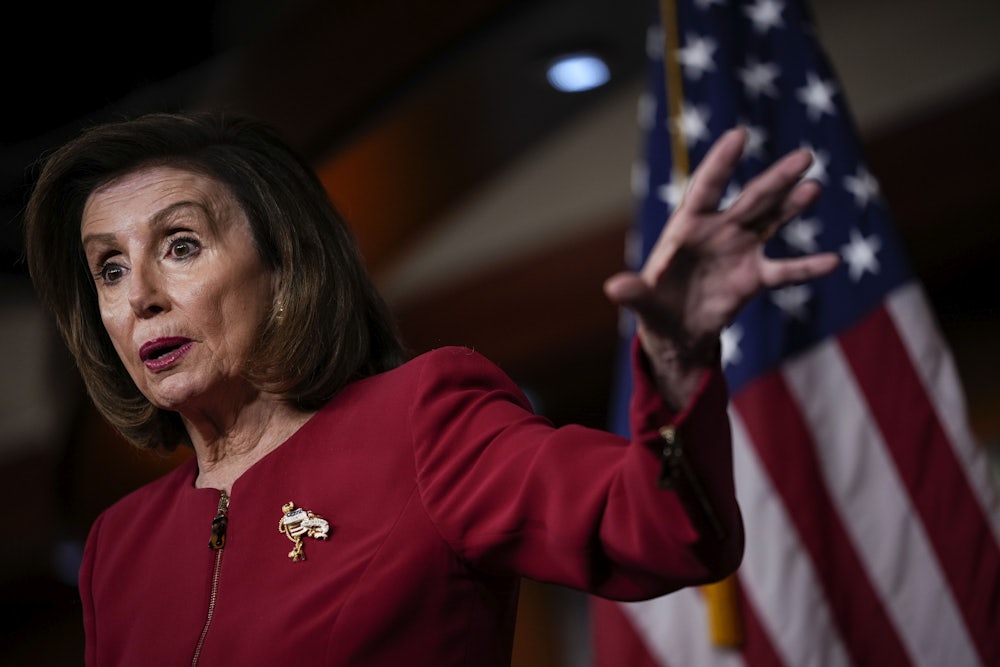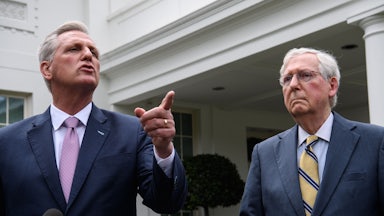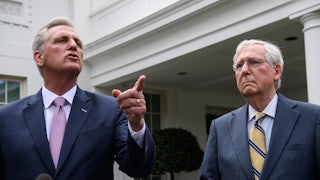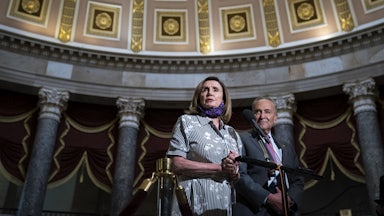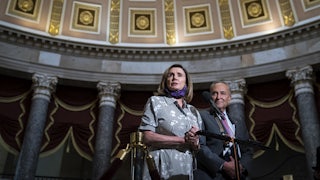Once upon a time, in a less polarized era, the periodic need to “raise the debt ceiling” was an occasion lawmakers used to refocus the political conversation on the national debt. Those days are past: It has since become a powerful weapon of political brinkmanship, one with the power to send the global economy into a tailspin amid a deadly pandemic.
In the simplest of terms, for the benefit of readers who, like your author, have trouble understanding the debt ceiling and the fuss that accompanies its increase: The debt ceiling is the limit for the federal debt, including both debt held by the public and debt held by government agencies. Raising the debt ceiling does not spend any new money or incur any additional debt; rather, it allows the Treasury to borrow money to cover prior congressional spending.
“It’s a funny kind of tool that can only hurt us,” said Laura Blessing, a senior fellow at Georgetown’s Government Affairs Institute, about the debt ceiling. Unless Congress raises the limit for what the government can borrow, the Treasury will default on its debts. One would think that the specter of this obviously terrible outcome would be enough to deter Congress from conducting semi-regular games of chicken, and yet, here we are.
In 2019, Congress opted to suspend the debt ceiling for two years, setting July 31 of this year as the date in which the Treasury could no longer borrow more. (There’s a slight difference between raising and suspending the ceiling: Raising the ceiling gives a fixed number to how much the government can borrow, suspending it kicks the can down the road such that the country can continue borrowing for a period of time but hit the ceiling on a certain date.)
The suspension meant that the debt limit of $22 trillion in 2019 was reset on August 1, and reinstated at roughly $28.5 trillion. The following day, Treasury Secretary Janet Yellen informed Congress that the Treasury was taking “extraordinary measures” through the end of September so that it could continue paying its obligations.
“The fact that we even moved into using extraordinary measures, as though that’s normal practice, just is a reflection of how irresponsible Congress has become at doing the things that need to get done,” said Maya MacGuineas, the president of the Committee for a Responsible Federal Budget, a nonprofit watchdog organization.
Yellen warned in a letter to Speaker Nancy Pelosi on Wednesday that these extraordinary measures would likely run out sometime in October. She cautioned Congress against “waiting until the last minute,” adding that a delay in action would “likely cause irreparable damage to the U.S. economy and global financial markets.” A global pandemic is a “particularly irresponsible” time to “put the full faith and credit of the United States at risk,” Yellen said.
Because no one’s ever been crazy enough not to raise the debt ceiling in a responsible manner, we only have a theoretical understanding about what might happen if Congress doesn’t act, and the country defaults on its debt on “X Date,” when extraordinary measures will run out. Suffice it to say: It will be very bad. The Treasury Department, for instance, won’t be able to make payments on critical priorities such as Social Security, Medicare and Medicaid, military pay, and veterans’ benefits.
“This event would be unprecedented in the modern era, like nothing we’ve ever seen before,” said Shai Akabas, the director of economic policy at the Bipartisan Policy Center, a Washington think tank. (The BPC estimates that the “X Date” will occur sometime between mid-October and mid-November.)
If we reach X Date (which seems like as good a name as any for the day lawmakers might wreck the economy, so let’s stick with it), the Treasury Department may attempt to prioritize certain payments, such as interest on federal debt, or for key social programs. But this would mean that other payments would not be made on time. Another option would be for the Treasury to try to wait until it can pay one day’s worth of debts, which would result in growing delays.
Another fun fact is that the global financial system is also highly dependent on U.S. Treasury bonds, and if the country is unable to pay interest, it could have international repercussions. Think of risks like recession, spiking interest rates, and volatility in world markets.
“We don’t know which of these consequences are going to materialize and exactly when they would materialize, but we know that there are a lot of possible risks,” Akabas said.
Yellen’s warning to Congress harkens back to 2011, when the country came so close to defaulting on its debts that credit rating agency Standard & Poor’s downgraded the nation’s credit for the first time. That crisis was ultimately averted by a deal hashed out between then–Vice President Joe Biden and Senate Minority Leader Mitch McConnell. (After the deal was reached, McConnell said that he believed the debt ceiling was a “hostage worth ransoming,” as it focused Congress on addressing the national debt.)
The deal to suspend the debt ceiling in 2019, part of an agreement by Pelosi and former Treasury Secretary Steven Mnuchin, was reached with little drama. But that was back when Donald Trump was president and Republicans controlled the Senate—two years later, the political landscape is different. President Joe Biden is now in office, and Democrats have razor-thin majorities in both houses of Congress.
But with control of only 50 seats in the Senate—stop me if you’ve heard this before!—Democrats need support from at least 10 Republicans in order to pass most legislation, including a debt-limit increase.
Republicans have signaled unwillingness to raise the debt ceiling, blasting what they see as unchecked spending by the Democrats in power. As early as May, Senate Minority Whip John Thune told reporters that it was “unlikely” 10 Republicans would vote for a debt ceiling increase without some spending cuts.
McConnell said last month that it was Democrats’ “obligation to govern,” and that “the essence of governing is to raise the debt ceiling to cover the debt.” In an interview with The Louisville Courier-Journal published Thursday, McConnell said that “America must never default” but argued that the onus was on the Democrats to raise the limit.
“The debt ceiling needs to be raised. The issue is who should do it. And under these uniquely unprecedented circumstances, it’s their obligation to do it,” McConnell said.
Republicans point out—correctly—that Democrats technically don’t need their help to raise the debt ceiling. They could just tie it to their potpourri of policy priorities known as the reconciliation bill, using a process that would allow it to be approved with a simple majority in the Senate and therefore no Republican votes. This would likely be the safest approach to ensuring the debt ceiling is raised.
But Democrats hit back that the debt ceiling is a bipartisan issue and that the latest round of debt was primarily racked up under a Republican president. Pelosi said Wednesday that a debt ceiling hike would not be included in reconciliation, and argued that raising the limit was necessary to pay off debts incurred by the “Trump credit card.”
“When President Trump was President, we, Democrats, supported lifting the debt ceiling because it’s the responsible thing to do. I would hope that the Republicans would act in a similarly responsible way,” Pelosi said. Senate Majority Leader Chuck Schumer said separately on Wednesday that “it would be just the height of irresponsibility for Republicans to play games, to take the debt limit hostage.”
Both parties hold responsibility for the roughly $6.5 trillion in debt that the country has incurred since 2019. Some of that debt came from the nearly $2 trillion Republican tax overhaul in 2017, and some from the $1.9 trillion coronavirus relief measure spearheaded by Democrats in March, both of which passed along partisan lines through reconciliation. Some of it also comes from the initial coronavirus relief measures that passed last year with bipartisan support.
Democrats could potentially lure Republican votes by tying a provision raising or suspending the debt ceiling to a continuing resolution, or C.R., funding the government. Biden has also asked Congress to provide emergency funding for hurricane relief and for resettling Afghan refugees, which could also be rolled into the C.R. Schumer and Pelosi have stayed mum on whether they will decide to go this route.
“We have a number of different ways we’re going to look at getting the debt ceiling done. We must get it done and stay tuned,” Schumer said Wednesday.
If Democrats decide to bundle all of these issues together, they would basically be daring Republicans to let the country default on its debts—along with allowing government funding to expire and voting down emergency relief.
“What we’re creating is a showdown where Democrats are trying to show that the Republicans are being irresponsible, but the cost of proving that irresponsibility is an economic worldwide catastrophe,” Blessing said.
Even if we don’t default on our debts, just getting close to the X Date could have negative effects on the economy. S&P downgraded the country’s credit rating in 2011 not because the default had occurred but because of the threat presented by political brinkmanship.
As we get closer to the X Date, it’s possible that multiple credit rating agencies could downgrade the country’s credit. If that happened, it could have ripple effects for the national economy and for our status as the world’s reserve currency.
Waiting to act could also be costly. “We know that investors are already starting to demand higher interest rates on Treasury securities that are returning around the timing of the X Date, because they have even a slightly elevated concern that the U.S. might not make good on its debts,” Akabas said. Higher rates costs taxpayers more, because we would otherwise be paying lower rates on the Treasury bills.
“The sooner that Congress addresses the debt limit, the sooner those risks will be mitigated, and the lower the costs will be,” Akabas said. But once Congress acts, either by raising the debt ceiling to a fixed amount or by suspending it to a certain date, that just ensures we will be dealing with this problem all over again in a few years.
Congress could, theoretically, eliminate the debt ceiling. Several Democrats introduced bicameral legislation in May that would repeal the limit. “The recurring fight over the debt limit is a manufactured political crisis,” Senator Michael Bennet said in a statement announcing the bill. However, legislation doing away with the debt ceiling altogether is unlikely to pass. A more realistic route may be to reform the practice of raising the debt ceiling.
“There is an increasing recognition by both parties that the debt limit has become really a purely political tool that is not serving any meaningful purpose in its present form,” Akabas said.
Some experts have advocated for the resurrection of the Gephardt Rule—so named for former Representative Dick Gephardt—which allowed for a debt-limit increase to be authorized every time Congress passed a budget. This rule was in use between 1979 and 1995, until Republicans took control of both houses of Congress and suspended it. Thus began the modern era of using the debt ceiling as a political football, and then stuffing that football full of time bombs in 2011.
But this isn’t Dick Gephardt’s House. Congress doesn’t pass budget resolutions with consistency anymore, nor does it follow the formal timeline for passing budget and appropriations bills. (In accordance with the Congressional Budget Act of 1974, Congress is supposed to have completed action on a budget resolution by April 15.)
MacGuineas suggested that Congress could take a vote to raise the limit at the same time it votes on legislation that would incur debt. So, for example, after voting for the 2017 tax cuts that increased the debt, members of Congress would have also had to vote to increase the debt ceiling “to show the effects that it has on the budget.”
Akabas has proposed “derisking” the debt ceiling by linking it to the budget process. If Congress fails to pass a budget resolution by April, the president could be authorized to suspend the debt limit until the end of the following fiscal year, and also offer a debt-reduction proposal, such as through spending cuts or tax increases. This would force Congress to consider debt-reduction legislation.
Debt-reduction measures may not be popular, but the national debt is fast approaching $30 trillion. Multiple things can be true: The debt limit needs to be raised or suspended, and we need to somehow address the massive amounts of debt that the country is incurring. But these issues can’t be resolved while the debt ceiling is being used as a political cudgel, with the global economy as collateral.
“They need to leave the gun and take the cannoli. We’ve got to find a better way,” Blessing said.
